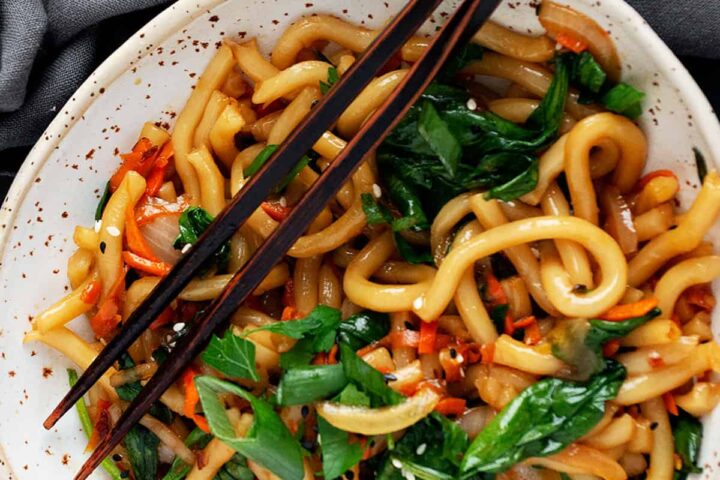Japanese udon noodles are thick and delicious in stir-fries, salads, and soups. We’ve rounded up 12 of the best Udon Noodle Recipes, each of which is quick, simple to make, and full of mouthwatering flavor, making them perfect for busy weeknights.
One of the most widely consumed noodles in Japanese cuisine is udon. They cook quickly, and the majority of the recipes listed below can be prepared in under 30 minutes. You can easily find these noodles online from Amazon or in most Asian grocery stores.
How to Cook Udon Noodles for Stir Frying
The vacuum-packaged udon noodles (shown above) can be found in the freezer or refrigerator of your Asian grocery store.
Better to Use Frozen Udon Noodles
If possible, freeze the packet of precooked udon noodles before cooking. Alternatively, you may use them straight from the refrigerator. But after a number of tests, I discovered that the texture of this dish is slightly improved by using frozen udon noodles. More on this below:
Udon noodles are known for their chewy texture, and using frozen udon noodles keeps them from getting mushy and overcooked.
Drop your udon noodles—frozen or not—into the just-becoming-boiling water. Because the udon noodles are cold, once they’re in the boiling water, the temperature will drop and the water will stop boiling. The water is just hot enough to separate the noodles, so that’s good because it prevents them from overcooking. Udon noodle texture should be chewy yet soft. Noodles should be gently stirred until separated and flexible strands. This should take 1 – 2 minutes.
Noodles should not be overcooked because they are already cooked when they are packaged, and if they are, they will become mushy and soft. Wait for the noodles to separate naturally, then gently stir them. Avoid tearing the noodles by prying them apart.
Take the noodles out of the hot water as soon as they separate and become pliable, and then immediately rinse them with cold water.
How to Make this Spicy Udon Stir Fry: Step-by-Step
Step 1: Gather your ingredients and mix up your sauce.
Step 2: If you’d like, let your noodles soak while the oil in your wok is heating up over medium-high heat. The carrots and onions are then added, and they are stirred in the hot wok until soft.
Step 3: Add the noodles and stir-fry them briefly to get rid of any water. Add the sauce and toss to coat. Lastly, add the spinach and continue to stir-fry it until it wilts. Spoon into bowls, garnish and serve!.
This recipe will serve 2 as a main dish or 4 as a side dish. To serve more, simply double the recipe!
Almost any vegetable or green can be used in the stir fry to vary the vegetables. The length of time it will take to cook in the pan is the only factor. Before adding the noodles and sauce, make sure that whatever you add is crisp-tender in the pan.
Chicken is a great protein to add to this dish, either cooked chicken or chicken that has already been cooked in the wok before the stir fry begins (remove to a plate, then stir in again toward the end to reheat).

FAQ
What toppings can I add to udon?
While there are many different types of condiments that can be used to top udon, the majority of stores carry scallions, shredded nori seaweed, and hot chili peppers (ichimi and shichimi types). Depending on the retailer, agedama (fried tempura crumbs) and ginger are also offered.
What can I add to instant udon?
Whatever you have on hand, including bok choy, carrots, spinach, mushrooms, and kale, will work.
How do you prepare store bought udon?
When boiling semi-dried (slightly flexible, shelf stable) udon, wait 6-7 minutes before checking for doneness; when boiling dried (brittle, shelf stable) udon, wait 9–10 minutes. Take a noodle out of the pot, submerge it in cold water, and then bite into it as a test.
How is udon traditionally served?
Udon noodles can be served cold with a dipping sauce in addition to the traditional hot broth in which they are typically served. Some of the more popular udon dishes are: Kake udon. Udon is best served in the noodle broth known as kakejiru, which is made of dashi, soy sauce, and mirin.